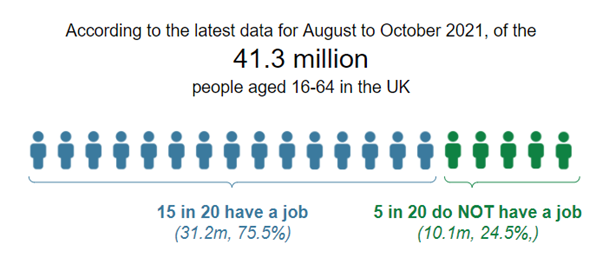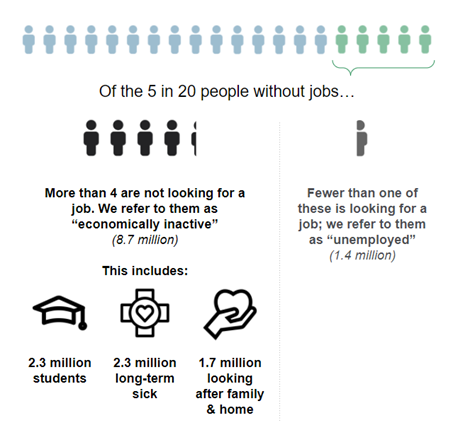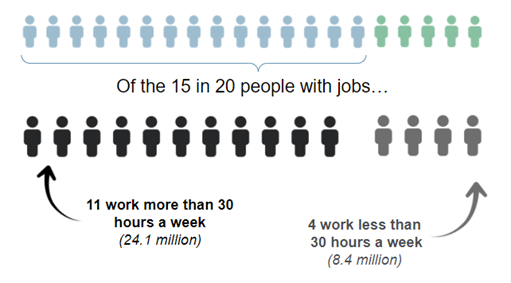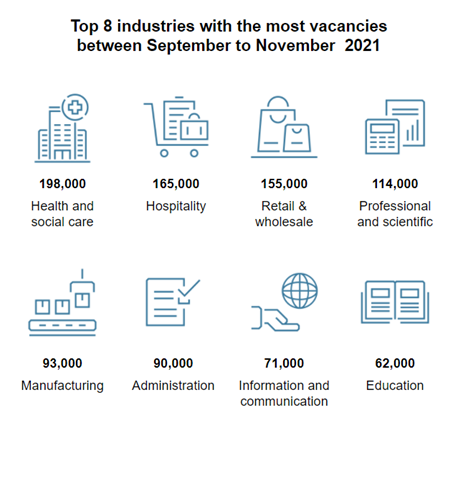Summary
- 76% of adults aged 16-64 have jobs, according to the latest data for August to October 2021.
- The number of people with jobs has gone up recently, but the number of people with jobs still is not as high as it was before the pandemic.
- Employers are advertising more job openings than usual.
How many people have jobs?
 Source: ONS LFS
Source: ONS LFS
Read more
 Source: ONS LFS
Source: ONS LFS
Read more


Case study: Esme & Oliver
Neither Esme nor Oliver are working at the moment. There are 10.1m other people in the UK who are not working like them.
Esme was recently laid off from her job at a bank and is in the process of looking for a new one. Because Esme is not working and is actively searching for a new job, we refer to her as unemployed. Approximately 1.4m people in the UK are unemployed.
Most people in the UK who are not working are classified as economically inactive. This is about 8.7m people. This includes people like Oliver, who cares full-time for his two young children and doesn’t work outside of the home. Because of this, we refer to him as economically inactive in official statistics. We do not consider him as unemployed because he is not looking for work.

Anyone who is of working age who is not working and not looking for work is considered economically inactive, so this also includes people like Michael, Oliver’s cousin who is at university full-time.

It also includes Oliver’s mother, Jane, who retired early to spend more time with her grandkids. Other people may be economically inactive because they are sick or disabled, whether temporarily or long-term.
 Source: ONS LFS
Source: ONS LFS
Read more


Case study: Nadia & Amber
Nadia and Amber work together in a grocery store. Nadia is a manager and works at the shop 35 hours a week on a salary. Of the 31.2m people in the UK that are working, 24.1 million, like Nadia, work more than 30 hours a week.
Another 8.4m people work less than 30 hours a week. This includes people like Amber. She works 10-15 hours a week at the grocery store while she also completes a training course part-time.
How many people have jobs compared to before the pandemic?
| Before the pandemic | Early 2021 | Most recent figures | |
|---|---|---|---|
In work (As a percentage of people aged 16-64) |
31.7 million 76.6% |
30.8 million 74.6% |
31.2 million 75.5% |
Economically inactive (As a percentage of people aged 16-64) |
8.4 million 20.2% |
8.8 million 21.3% |
8.7 million 21.2% |
Unemployed (As a percentage of people aged 16-64 who have a job or are looking for one) |
1.3 million 4.0% |
1.7 million 5.3% |
1.4 million 4.3% |
Source: ONS LFS
Read more


Case study: Esme & Oliver
Through the pandemic, many people stopped working or lost their jobs. Today, there are 500,000 fewer people with jobs than there were before the pandemic.
The number of people who were economically inactive, like Oliver, and his cousin Michael, also went up through the pandemic. While it has gone down in recent months, there are 380,000 more people who are economically inactive than before the pandemic.

There are lots of reasons for this. For example, lots more people decided to start studying. There are 210,000 more students in the UK than before the pandemic. Michael was working at a technology company, but decided to go back to school and retrain.

The number of people unemployed, like Esme, increased through the pandemic, and then fell. You may often hear about the “unemployment rate” – this is the number of unemployed people as a share of people who either have a job or are looking for one.
The unemployment rate rose through the pandemic and then fell.
It is currently 4.3%. Before the pandemic it was 4.0%. This means there are approximately 57,000 more people looking for jobs today compared to before the pandemic.
How many job openings are there?

Source: ONS LFS
Read more


Case study: Nadia & Amber
1.2 million job openings, also known as vacancies, were advertised in September to November 2021. This is a rise of more than 400,000 compared to before the pandemic and a record high. All lines of work have at least as many jobs on offer now as before the pandemic.
Nadia, a manager in a grocery store, is hiring for a few different jobs in her shop. She has a sign in the shop window and is also advertising jobs online. Other businesses in the retail and wholesale industry like Nadia’s – as well as organisations in health and social care, and hospitality – need a lot of new people and are advertising for many more positions than usual.
Businesses like Nadia’s have told us that they are finding it harder than usual to find staff. They say that they aren’t getting enough applications from suitable candidates. Now might be a good time to think about getting training in skills that are in demand.
